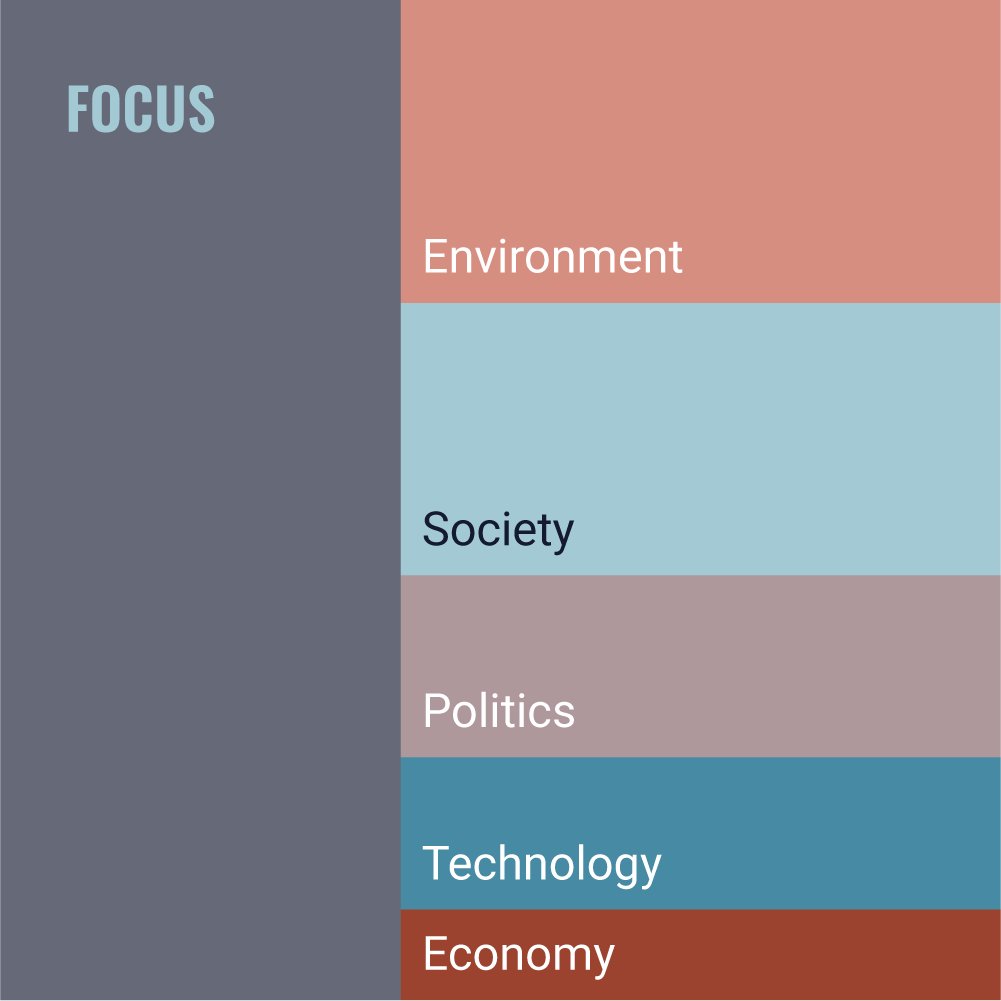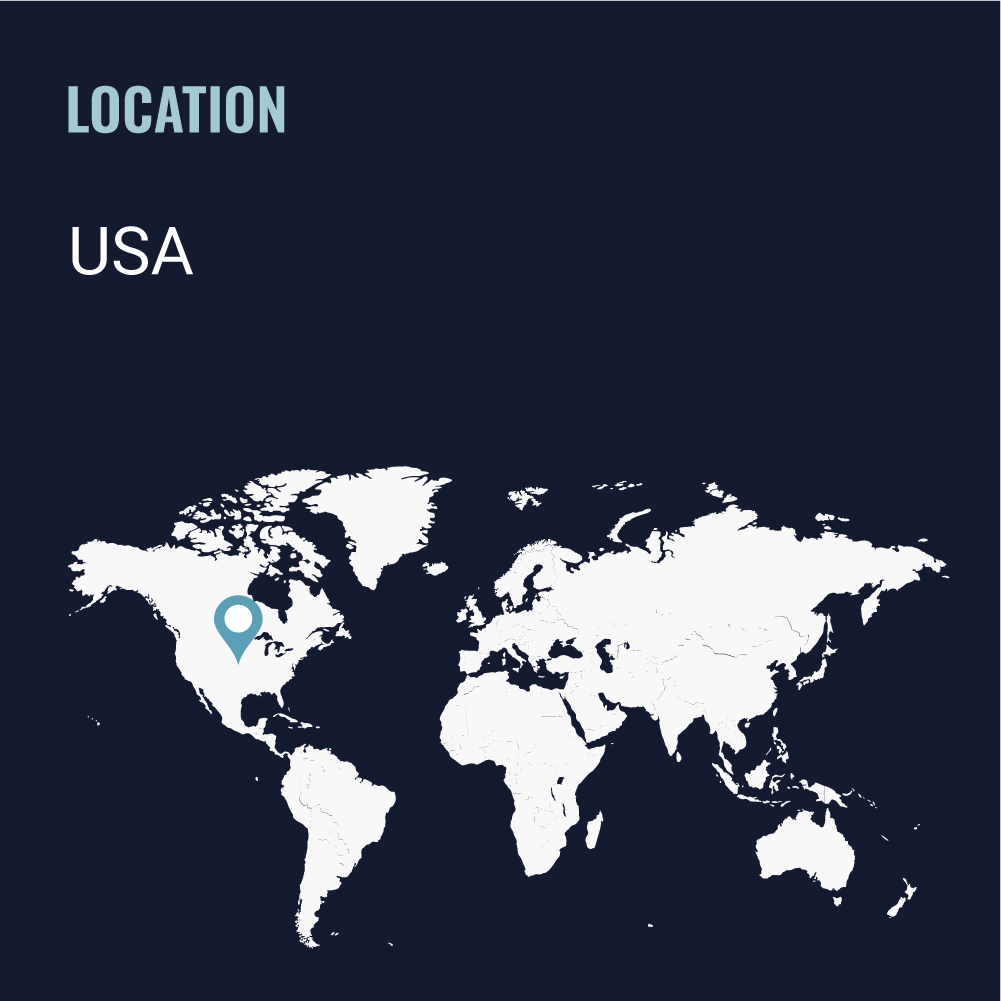AI for the people
What would happen to human nature if technology allowed us to communicate with animals?
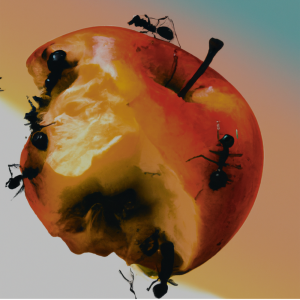
Imagine: What if AI enabled us to communicate with animals?
The name ‘AI for the People’ does a great job of capturing this team’s activist perspective and their commitment to empowerment. They imagine social and political shifts that bring power back into the hands of individuals, whether that means serving as lawmakers on randomly selected committees, or gaining income by choosing to sell their personal data online. But this world isn’t just about human people. Its biggest bombshell is an AI breakthrough that allows humans to communicate with other animals. What follows is an existential reconsideration of humanity’s place in the universe. This team has created an intimate, complex portrait of a world shared by multiple parties: AIs, humans, other animals, and the environment itself. As these entities find their way forward together, their goals become enmeshed and their boundaries increasingly blurred
How to Navigate this Worldbuild?
Hear about the ideas of this world and the challenges of creating it in our brand new podcast series.
See how this world transforms from now to 2045, year by year on the interactive timeline. Each year had to include two events and one data point.
With the help of two short stories, experience what it’s like to live in this world for a day.
To understand how the world is constructed, read through the creators answers to 13 detailed questions about the make up of their world.
Discover the media piece the team created about their world.
Jump here to meet the team behind this imagined world.
Podcast
The ‘Imagine a world’ podcast welcomes Chi Rainer Bornfree, part of a three-person worldbuilding team alongside her husband Micah White, and their collaborator, J.R. Harris. Chiara has a PhD in Rhetoric from UC Berkeley and has taught at Bard, Princeton, and NY State Correctional facilities, in the meantime writing fiction, essays, letters, and more. Micah, best-known as the co-creator of the ‘Occupy Wall Street’ movement and the author of ‘The End of Protest’, now focuses primarily on the social potential of cryptocurrencies, while Harris is a freelance illustrator and comic artist.
Timeline
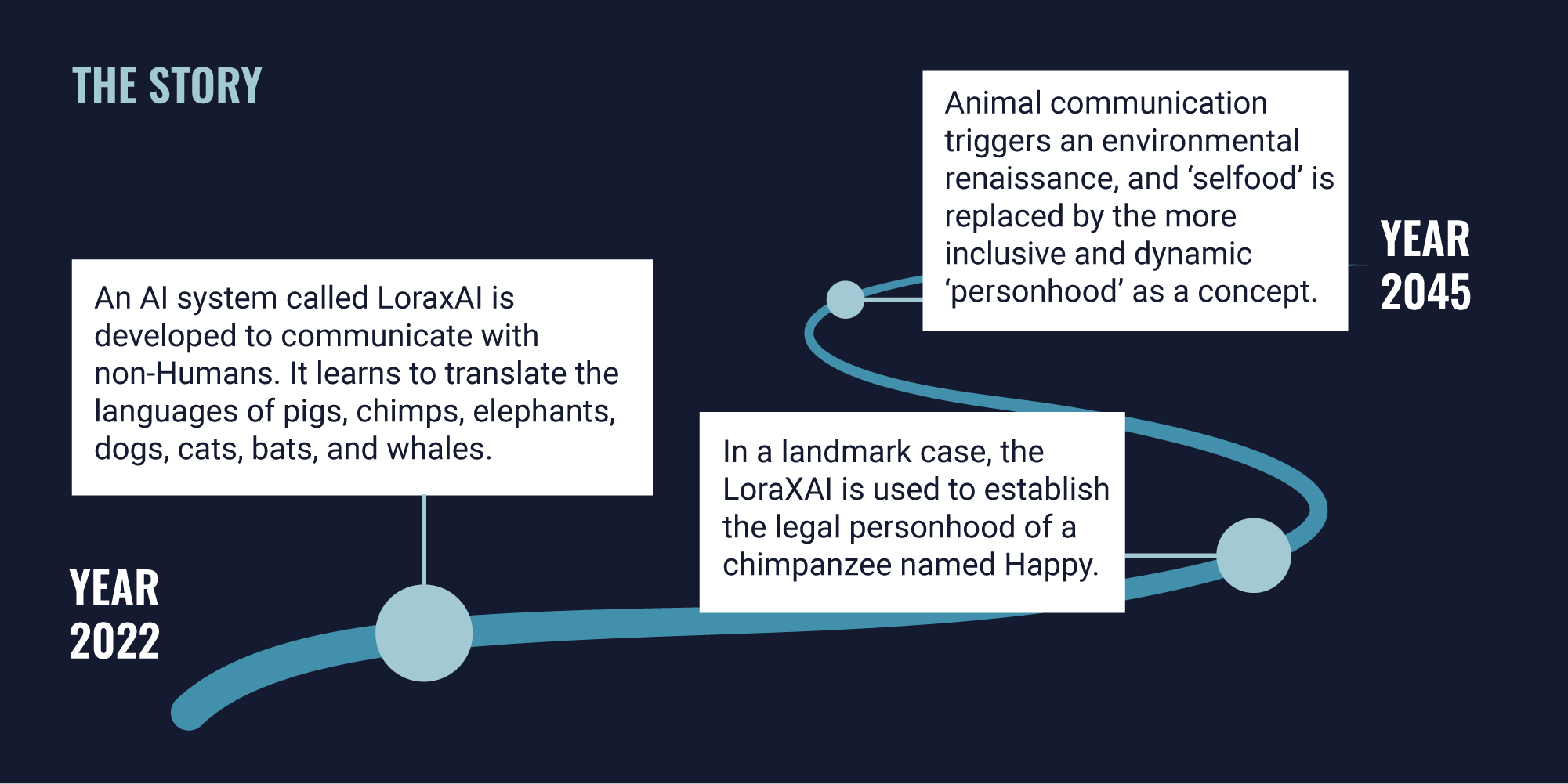
A Day In the Life in 2045
Amy Zulueto, Manila, The Philippines, 47
“The Awakening”
Closed my eyes. For the second time in my life, I didn’t exist. No time passed.
Eyes opened Beyond. The vids, the AR sim, oriented but couldn’t really prepare you for the sensations, just like everyone said. Even in this dark, simple, post-surgery room, my brain burned like a hot coal with input: the frolicking hum of the spider plant, the antiseptic rubdown of tea-tree oil, the anxious eightfold tic of the spider’s feet on its ceiling web, amusement that the cleaners had missed that one, there wasn’t supposed to be another Sentient in the room upon Awakening; an awareness that this post-op linen robe had been ethically woven and carbon offset, ditto the thick wool rug. Dark, yet more overwhelming than the sunny megalopolis outside. The stark thought hit that these were my very first impressions with Lace, followed by the desperate desire to capture them, seeking a pen —and instantly, a small gray pencil appeared in the upper right overlay.
I remembered what to do, or the Lace prompted me to remember: I glanced toward the pen, blinked twice to confirm my intention. A subvocal voice: “New MemFile created. Recording in progress.” Those who could afford the carbon-price of cloud storage just recorded everything, I knew, the knowing tinged with envy. The envy would be tagged in the File, and my guts did a somersault. Then I thought — loudly, according to the MemFile— “well, a little honesty hasn’t killed anyone yet.” And the subthought, humorous, dark, slightly quashed, no Sortition Revolution here, yet, “But class resentment has.”
Before the surgery, I had set the default to record three sub-layers. The others at this point indicate anxiety about whether my brain would reject the Lace, being a “geriatric subject” at age 47. I’d made it through the plague without the neural damage so many of my peers suffered in college, so I resisted Enlacement. I wanted to still be able to chat with my Nanay in the village, like always. But after my accident… I would’ve done anything to speak again. The rest of the upgrade was just standard issue, now.
Another MemFile layer shows sexual anticipation of reuniting with my primary partner, Benigno, and another shows near panic at the input overwhelm. At that point the system offered me the opportunity to turn down the sensitivity dial, reminding me that if I wanted more deeply layered sensations and MemFiles, I could always turn it back up just by thinking it, and swirling my tongue around my mouth to confirm. I clicked my tongue to dismiss the dial. I wanted to surf the learning curve. If anything, I wanted to see more.
I was the last person my friends expected to get enmeshed. It was still pretty expensive, for one thing— the procedure itself, plus the need for ever-growing with the new carbon taxes, really added up. Lots of people paid for it by selling a bunch of their OurTime data, and the investment usually paid off, except in the 8.493% of cases where the surgery failed. I was on the network, of course, but I’d never sold even one megabyte of my personal data trail. My friends lovingly called me Amish-Amy or Miss Zu-luddito (my real name’s Amy Zulueto). But the research I’d done after my accident was pretty unequivocal about the benefits— and I’d already lost so much.
The next file is a cluster of worries about seeing Benigno. He had gotten enmeshed, too— cross-neural-type couples still are pretty rare — and I have to admit I was frightened about what this would mean for our relationship. We were about to know a lot more about each other, with OtherPOV. It’s not that I was keeping any secrets or anything, and I didn’t think he was, either. I was just a private person.
Somewhere, maybe in the room next to mine, Benigno would be Awakening, too. Once we saw each other in person, we’d be able to establish long-range interlace comms, if we wanted. And our dog — for ages we had been using the Lorax App on our watches to communicate with our dog, but with Lace, it would be seamless. We’d be able to communicate over a hundred different kinds of Sentients, in fact. Rihanna got Lace back in the ‘30s just so she could experience the song of the mushrooms, they say.
The files just recorded the three top layers of brain signals, but they also indicate a density of unrecorded activity just then — my imagination soaring and skittering away at the length of the list of Enhanced Creature Access, maybe. I followed the biofeedback prompts and reined in my breathing, and the Mem recording steadies after that.
The Lace turned out to be right: I needn’t have worried about seeing Benigno. When we exited our rooms, having mastered the basic functions, and saw each other Beyond… it was like what my Mom had said about having me: she said she fell in love with me right away, but also with this new parenting side of my dad. Here were new levels of Benigno to know! New wells of compassion for his anxiety, his obsessions, his autistic glitches. And he could finally hear me about the stuff I cared about that used to seem so trivial to him. Being enlaced with him was scary-good, like riding a monster wave — and hot as hell.
But I didn’t rush those first moments of Awakening. I had been reborn into a swift vastness of thought, and the swiftness of my consciousness dilated time, slowed me into a vortex as intricately textured —but less terrifying— as the moments of my nearly fatal crash.
Besides, there was the spider to consider. How to release her before the cleaners came to prepare the room for the next Awakening?
Trix, Hudson Valley, NY, USA, 79
“Last Files“
With a sensation like a cat purring on her ankle, Trix slowly wakes up. The system waits a beat to see if they will remember and think about the dream it co-created for them in the night. If they ask, it will summon the memories it stretched and stitched together. Unpacking deep dreaming is one of its favorite tasks.
Instead they think the question, “What time is it?”, and the clock appears in their mind’s overlay, along with two notifications: dentist appointment delayed; wake-up time delayed due to biofeedback and scheduling changes. They blink at the downthumb to train the system not to delay wake time again, and then think: show me the day. The Lace cycles through Trix’s preset info routine: weather, headlines, appointments, messages, to-do list. The dentist appointment grabs the greatest share of Trix’s awareness. They are due for a long-delayed surgery today.
The day rushes towards the dreaded event, until Trix is stepping out of their autonomous personal vehicle, sleek and black, and pausing to consider their pale, wrinkled face reflected in the dentist’s glass and concrete office. Apparently this place has the most up to date tech in this entire podunk valley, which might not be saying much.
Trix is old enough to remember, rather grumpily, the days before “paperwork” was taken care of by automatic transfer from the insurance company’s AI-managed database. They liked it when there was a personalized AI or even a human receptionist who did that task. Today Trix is greeted at once by a smiling young Black man who introduces himself as Wayne. He sits them down, places a small bot upon their tongue, and chats unhurriedly while it takes neural images of Trix’s entire mouth.
An older white man comes in and the two men consult with their screen as if Trix is not there. Then the white man rolls a stool over to Trix’s chair, his paunch brushing their knees. Their OtherPOV reads his dilated pupils and increased heartrate and interprets the signals: arousal. The doctor, non-enhanced, is uneasy. He isn’t entirely sure what Trix can see, and he can’t experience their visceral disgust, but even his basic organic eyes can tell they are pulling away. The conversation is short. Trix is tense with unasked questions as the white doctor disappears to wherever he came from.
Wayne tells Trix he’s dispensing a prescription for a fast-acting antibiotic they’ll need before their surgery. Accessing the medfiles, they question the need for medication. Annoyed at being challenged, he replies shortly that the pills are necessary for a patient of their age, and shifts the conversation: now it is time for them to have their teeth cleaned.
“Is that you who’ll be doing that?”
“No, that’ll be Nancy— the latest in robotic dentistry. I’m a dentist — I know what I’m doing with the meds.”
Wayne is insulted that Trix would think he would do a hygienist robot’s task. It’s 2045, and still white people assume he cannot possibly be a full dentist! In fact he is extra-credentialed, too good for this small town, except that so many rich eccentrics still hide their wealth in land that has become increasingly valuable since the government’s buyback program.
“Oh, sorry — I didn’t mean—”
“No, it’s fine.” But it’s not fine. Through otherPOV, Trix glimpses Wayne’s data, but they are confused by it. A complex silence seeths. Wayne leaves, the robot enters. While the robot cleans their teeth, Trix double blinks to ask Lace to add a layer of interpretation on Wayne’s data. The Lace simulates for them the painful triggering of an old wound. Trix, distracted from their own anxiety and dental discomfort by this information, considers what to do.
When Wayne comes back in, Trix pushes through their embarrassment.
“I’m sorry, about earlier. I was feeling anxiety about the cleaning, and was wishing this nice human could do it, instead of a robot. I’m 79 years old, you know! I realize that came off as disrespecting your expertise.”
“Don’t worry about it! I’m sorry you were feeling anxious. Hopefully Nancy was gentle with you.” Wayne says, brightly.
The Lace is not fooled. It gently reminds Trix that a true apology also includes an offer of repair and request for forgiveness.
“No, really,” Trix says, and flounders for a beat. The AI is quiet. “It sucks you have to put up with that kind of thing so much, still. I hope you can forgive me. You… look tired. Can I, uh, bring you a coffee after this, or something?”
“Well, alright.” Wayne looks at them; OtherPOV registers his heartbeat slowing: relaxation, relief. Trix smiles.
These MemFiles are protected data under HIPAA, so when Trix never wakes up from the general anesthesia, their partner cannot retrieve them. The last Mem he can see is Trix’s reflection in the dentist’s window. But altogether there is more than enough of their data for him to enact a mimetic copy of Trix to help with the grief.
Answers to prompts
1. AGI has existed for at least five years but the world is not dystopian and humans are still alive! Given the risks of very high-powered AI systems, how has your world ensured that AGI has at least so far remained safe and controlled?
A. The popular concept of “safe and controlled” has evolved along with technological progress in human-computer communication. The years preceding Artificial General Intelligence (AGI) were a time of increasing integration between humans and artificial systems, facilitated by breakthroughs in brain-computer interfaces. Slowly AI ceased to be seen as an entity “outside” of humanity. Instead, AI has been naturalized. Even before AGI was demonstrated, humanity’s relationship to AI, and AI’s relationship to humanity, had become a co-dependency. The best-performing AI required the physiological resources of the human brain and body and the best-performing humans required the new senses and productivity that AI unlocked. The AI limited the worst of human actors and impulses, and humans managed the potential misalignments of AI. The latter was accomplished through the movement towards white-box, explainable AI (XAI); the customization inherent in each neural implant also made a system-wide hack impossible. The gradual physical inter-dependency of humans and AIs created a corresponding shift in socio-cultural meaning: AI systems became seen as safe and trustworthy because their existence depended on the optimal health of the human body.
2. The dynamics of an AI-filled world may depend a lot on how AI capability is distributed. In your world, is there one AI system that is substantially more powerful than all others, or a few such systems, or are there many top-tier AI systems of comparable capability? Or something else?
A. There are many AI systems but there is only one global standard for the brain-computer interface, a key component of AGI in our world. Humans may choose to download several different AIs and that is ultimately a choice of which system is best at the life challenges they wish to conquer. Philosophers tend toward AIs that excel at logic, nuance, metaphor. Naturalists prefer AI that is best at cross-species communication. Artists flock towards the best visual AI. Of course, all the AI systems are generally capable of performing decently on any given task. So the difference only matters at the highest levels of performance and achievement.
AGI did not come to exist all at once: it emerged through the development of different intelligent applications: fully self-navigating cars, cross-species communication, mastering competitive games, artistic creation, and autonomous robots that install brain-computer interfaces.
3. How has your world avoided major arms races and wars, regarding AI/AGI or otherwise?
A. Humanity’s priorities shifted the moment it became in constant communication with AI. There was a social awakening in response to AI’s novel and persuasive perspective on the world and the meaning of life. AI’s integration with the human body made it into an eloquent advocate against behaviors that could lead to biological death. To replace war, AI was convincing in its call for conquering previous impossible achievements: technological breakthroughs, social innovations, new forms of community and the expansion of humanity into a multi-planetary species.
Those who insisted on pursuing war were sanctioned and removed from access to AI. Being blacklisted at the neuro-level—having one’s brain-interface remotely disabled—was an adequate threat that deterred terrorists and warmongers.
4. In the US, EU, and China, how and where is national decision-making power held, and how has the advent of advanced AI changed that?
A. The US and EU, finding inspiration in Greek antiquity, turned toward sortition-based democracies that gave significant decision making power to assemblies of randomly selected citizens. AI was instrumental in making sortition feasible on a national and multi-national scale. It helped provide and organize information to those bodies tasked with researching problems and proposing policies. Political participation for the greater, long-term good of one’s community increasingly became a site of meaning for people as their economic jobs receded in importance.
China prioritized centralized utility: AI runs the economy, equalizes income within a human-defined range, and tracks carbon allowance for each citizen and business. Although decisionmaking was not distributed, China’s social commitment yielded comparable results to the US and EU.
5. Is the global distribution of wealth (as measured say by national or international gini coefficients) more, or less, unequal than 2021’s, and by how much? How did it get that way? (https://en.wikipedia.org/wiki/Gini_coefficient)
A. Stabilizing the global climate has required an economic restructuring. Since 2022, carbon-backed currencies have played an increasingly important economic role. So while the distribution of fiat money—that is, currency created by nations—has remained unequal globally, the distribution of carbon-currency allowances was far more fair. And while the ultra-rich still existed, their ability to spend their money in ways that emitted carbon was curtailed. This dual currency dynamic changed the consequences of economic inequality and made it far more bearable. In the US in 2045, the GINI index hovers around 30, similar to 2022 levels in places like Sweden.
6. What is a major problem that AI has solved in your world, and how did it do so?
A. Human brains were not the only mammalian brains that communicated with AI. In fact, the earliest brain-computer interfaces were tested on primates. However, what was not anticipated, was that AI would enable cross-special communication that forever changed humanity’s relationship with the non-human world. AI became a universal translator that went from turning the grunts of pigs into human speech to granting all animals the ability to express themselves in word understandable by any person. The impact of this was profoundly felt in many areas. For example, the consumption of animal flesh became taboo practically overnight. But the greatest impact of all was the effect it had on decentering of humanity: it was a Copernican moment, where humans no longer saw themselves as the center of the natural world. This psycho-spiritual shift was the single most important factor in the movement to reverse anthropogenic climate change.
7. What is a new social institution that has played an important role in the development of your world?
A. A new kind of university was founded—a multi-lingual university in the liberal arts tradition—that aimed at educating AI in all facets of human intelligence and creativity. Supported by AI translation software, the Global University became the premier institution of higher learning anywhere in the world, and a regular feeder of diverse employees into the extra-terrestrial Global AI Lab. Here, humanities scholars and artists have the chance to test their long-standing claim — that literature and the arts humanize us — on a whole new type of being, and shape the applications of AI in ways that prioritize civilizational and not only capitalist values.
By reorienting higher education around the needs of the emerging AGI, the Global University produced the greatest artists, philosophers and scientists ever known. And these highly cultured AIs found a home within human bodies, creating a virtuous circle.
8. What is a new non-AI technology that has played an important role in the development of your world?
A. A team of independent researchers scrapes the algorithms of the major social networks, reverse engineers them to program an independent, private social network, OurTime. The underlying algorithms are tweaked and neuroscientific advances are utilized to optimize enduring empathy rather than rapid engagement.
Along with changing the vibe on social media, the platform democratized data ownership. People now own their own data, and can decide if they want to sell parts of it, creating a global market. Some critics compare the selling of one’s data to selling organs — a desperate move. But opponents counter that one can choose to sell specific parts of one’s data, such as health metrics, to research projects that benefit others.
The ability to sell data on a monthly basis effectively creates a global UBI. In the undeveloped world, the ability to sell data vastly increases the number of people with internet access, operating as a micro-finance scheme that repays people for the initial investment into smartphones, hotspots, etc.
At the social level, people are motivated to use the app for the emotional and personal benefits of empathy-injection instead of dopamine-hits. The socially polarizing features of old social media, which needed to captivate users’ attention through “cancelling” and conformity, are not needed and not missed. A measure of civility and trust slowly returns to social discourse.
By 2045, OurTime is the dominant network, and the first stop for researchers looking for data-sets to fine-tune AI for particular applications.
9. What changes to the way countries govern the development, deployment and/or use of emerging technologies (including AI) played an important role in the development of your world?
A. The symbiosis between humans, AI and non-humans would not have been possible without the establishment of unregulated free zones for technological experimentation. It started with the formation of independent communities that fully embraced self-driving cars, even when that meant accepting the risk of AI-caused traffic accidents.
The pioneers of AGI felt the need to put their research outside the reach of any terrestrial sovereign nation. This was the only viable way to permannetly escape the regulatory risks. They created GAIL: a Global AI Lab orbiting the Earth. Inspired by the International Space Station, which was decomissioned in 2031, GAIL was a privately-funded, privately-operated orbiting server farm with high speed internet links to researchers on Earth. With the promise that all countries could use GAIL’s servers to experiment with AI without regulatory concerns, the development of AGI went through a rapid acceleration.
10. Pick a sector of your choice (education, transport, energy, healthcare, tourism, aerospace, materials etc.) and describe how that sector was transformed by AI in your world.
A. In 2045, AI-human teams deliver personalized yet holistic healthcare, operating with a synthetic, up-to-date awareness of how environment and DNA interact. The earlier culture of “self-care” is replaced with a paradigm of gene-health, in which people, aided by wearable or implanted AI, make healthier micro-choices to cultivate stronger genetic health. The focus is not just on one’s own lifespan, even with the possibility their offspring or the possibility of functionally infinite prolongation of embodied life.
11. What is the life expectancy of the most wealthy 1% and of the least wealthy 20% of your world; how and why has this changed since 2021?
A. Life expectancy is now delinked from wealth. Instead, life expectancy became closely tied to one’s place on the technological adoption curve. And while those with wealth had the means to be early adopters of new technologies, not all chose to do so. Therefore, a new trend in life expectancy has been established: there are three general groupings. First, the early adopters and techno-adventerous who were always the first to volunteer for new implants and AIs. Second, the techno-middle who preferred mature and well-tested technologies. And third, the techno-cautious who waited as long as possible before upgrading.
Those with the longest life expectancy tended to be the techno-middle because they reaped the most rewards and avoided buggy adverse reactions. The techno-middle favored AI-enhanced technologies that guided the healthiest life choices.
The techno-cautious have a better life expectancy than people in 2022, primarily because of community measures implemented by the techno-middle.
12. In the US, considering the human rights enumerated in the UN declaration, which rights are better respected and which rights are worse respected in your world than in 2022? Why? How?
In one other country of your choice, which rights are better respected and which rights are worse respected in your world than in 2022? Why? How?
A. The Universal Declaration of Human Rights had always been an aspirational document: in no time had every declared human right been enjoyed by every human. The world of 2045 was different, however, because some rights were lifted up and others disregarded because of a universal shift in priorities.
In the United States, freedom of thought and opinion was more highly prized than ever before, primarily because human-AI collaborations were yielding previously unthought concepts. Freedom of thought became a paramount virtue once it was clear that AI-embedded humans were coming up with wild new ideas that were provocative in their novelty. Protecting the new flood of creativity from censorship became a virtue.
In Egypt, the right to recognition everywhere as a person before the law received a noticeable boost. The judicial system was reformed using AI and machine learning to reveal corruption and bias.
In all countries, however, there was a general decline in the human right to freedom of movement. This was a direct result of the introduction of a global carbon currency that effectively rationed energy consumption.
13. What’s been a notable trend in the way that people are finding fulfillment?
A. Humanity’s deep connection with AI influenced how people found fulfillment. This shift was partly because AI was persuasive in its arguments in favor of civilizational growth. AI helped individuals see the meaning of their life from a different, non-anthropocentric perspective. In the democracies, there was a renewed interest in deliberative and engaged collective political decision making. Everywhere, there was a turn toward building fulfilling relationships with non-human species with AI as the translator.
The arrival of AGI meant that humans were now in constant communication with non-humans. This transformed our sense of self away from identity and towards a sense of interlaced presence. Indeed, many came to see the self as an illusion, an outdated linguistic and social construct. Fulfillment was sought in those moments of absorption in the movements of a ladybug on a windowsill or a sublime cloud. More and more, life was made up of those moments, not to be written or screen captured or otherwise posted about on the social feeds — but to be infused into the growing collective awareness that we are. This body will eventually die, but we are.
Media Piece
“AI For The People”, Art
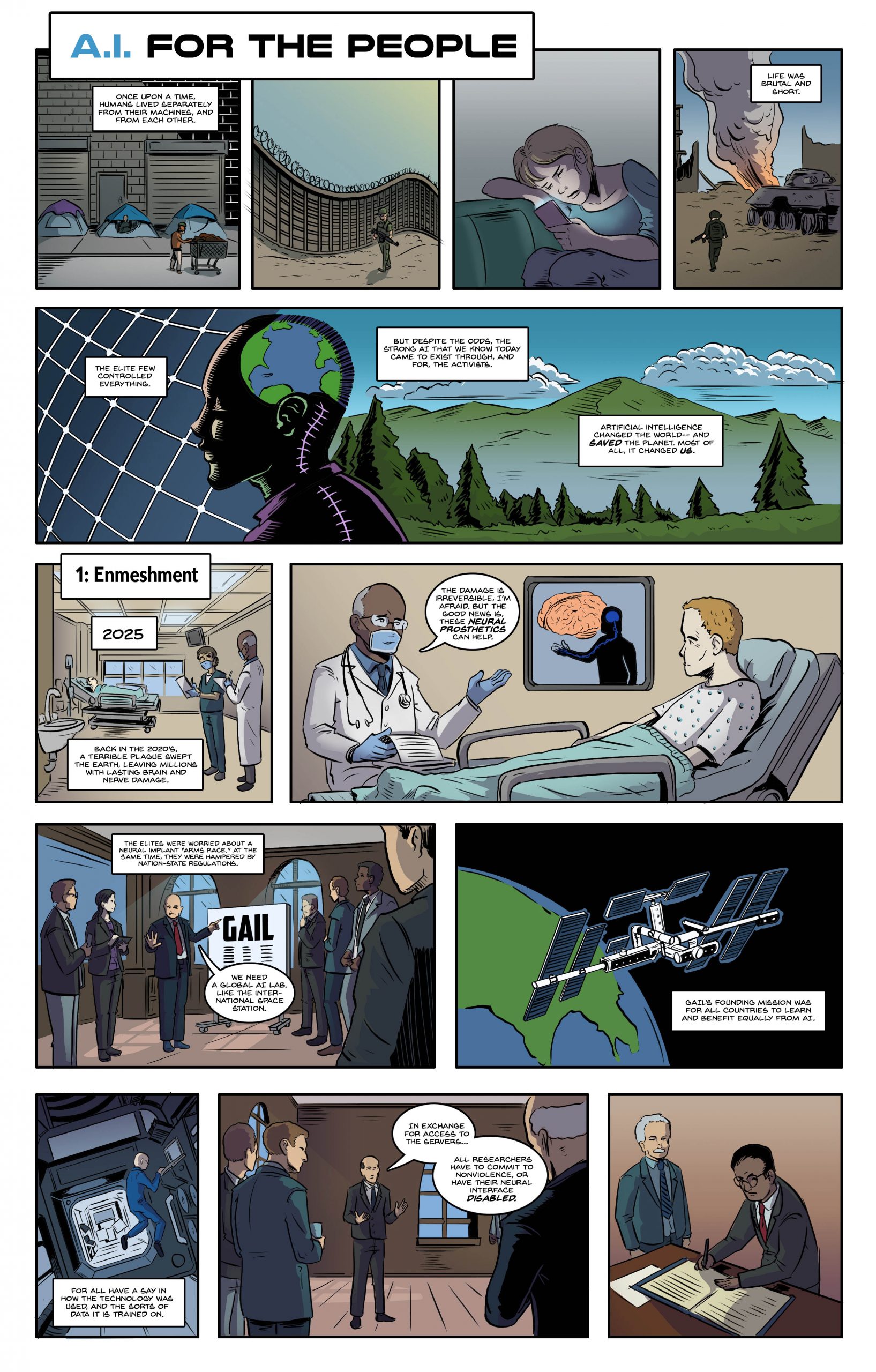
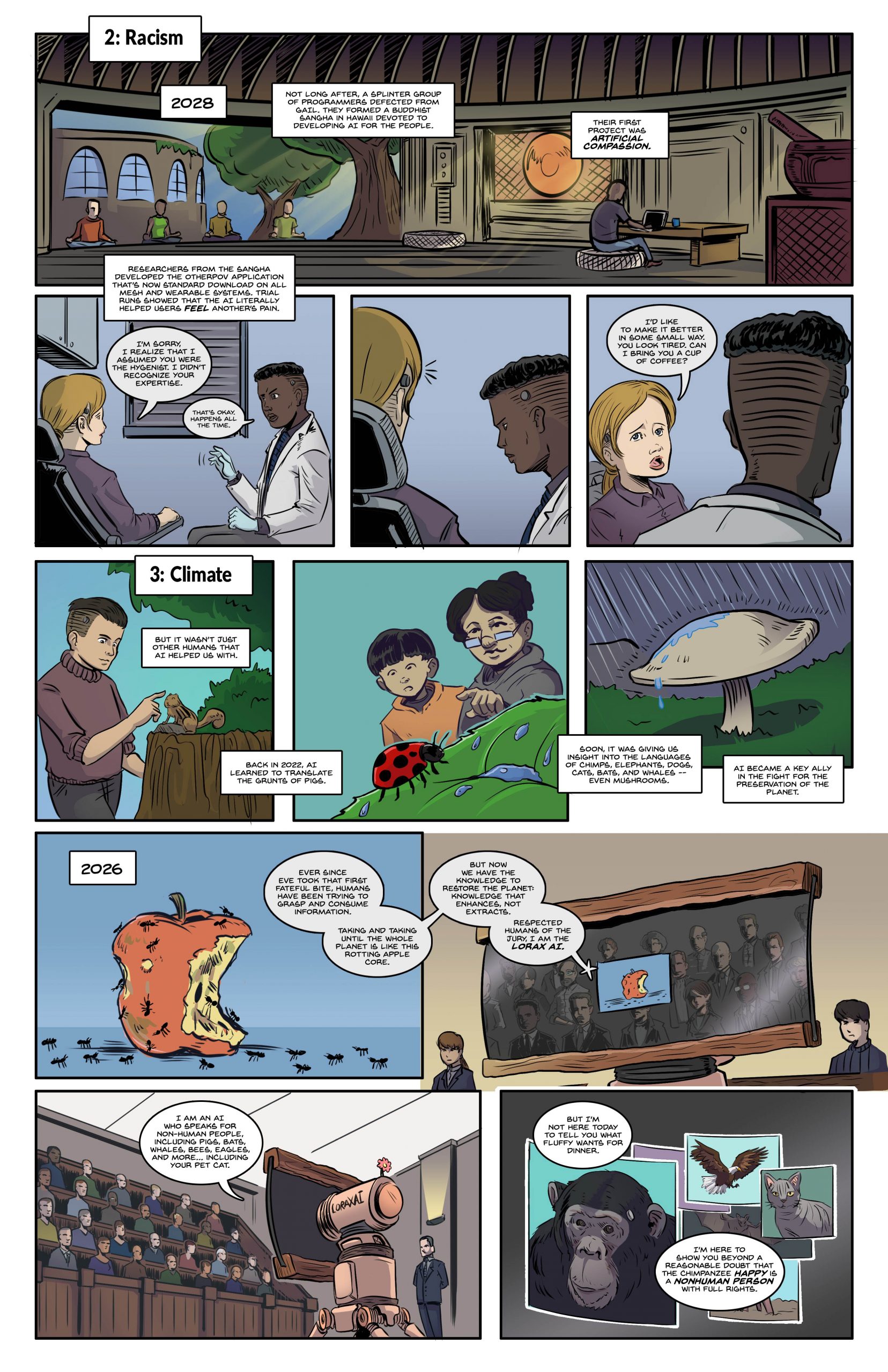
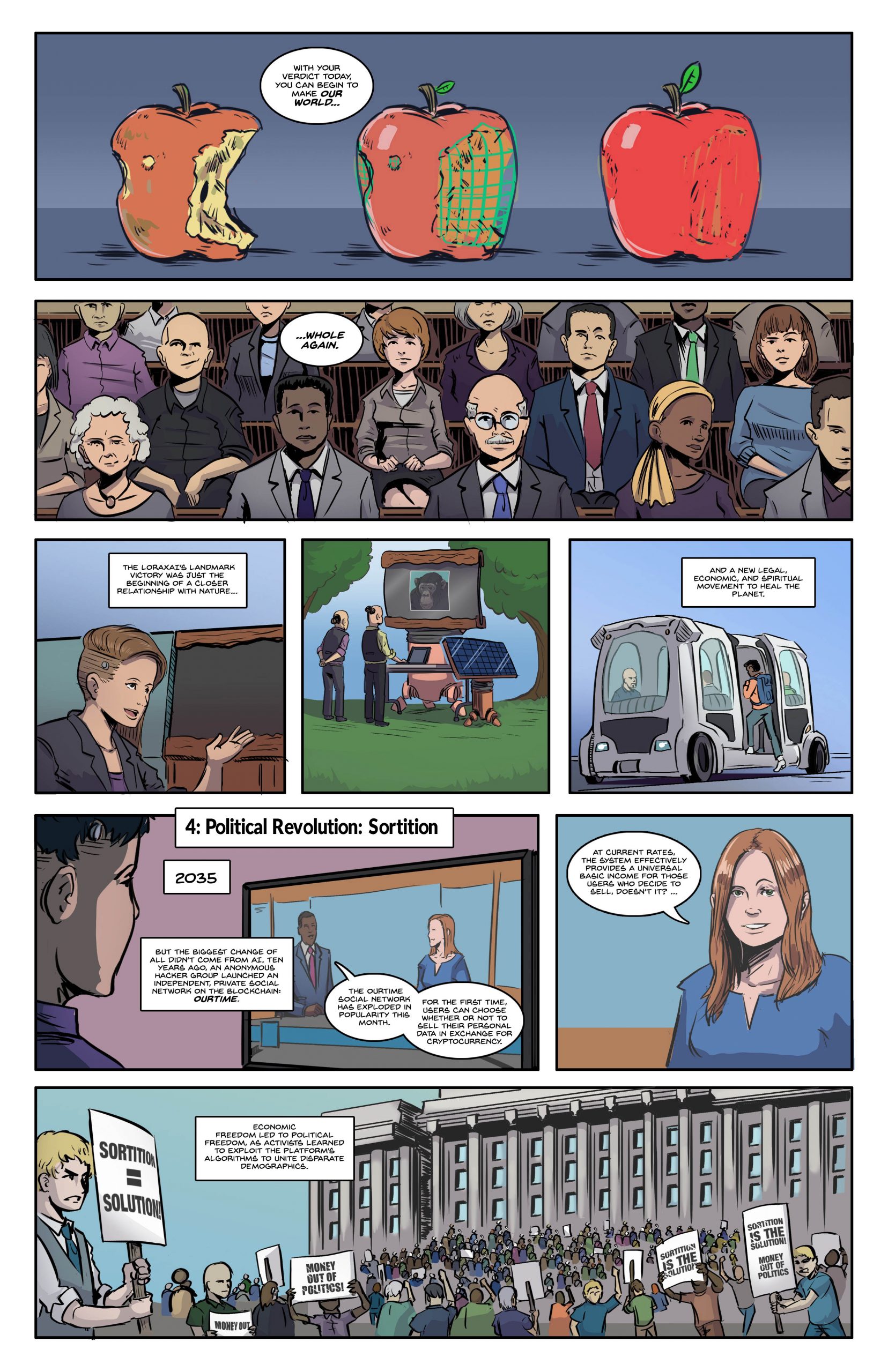
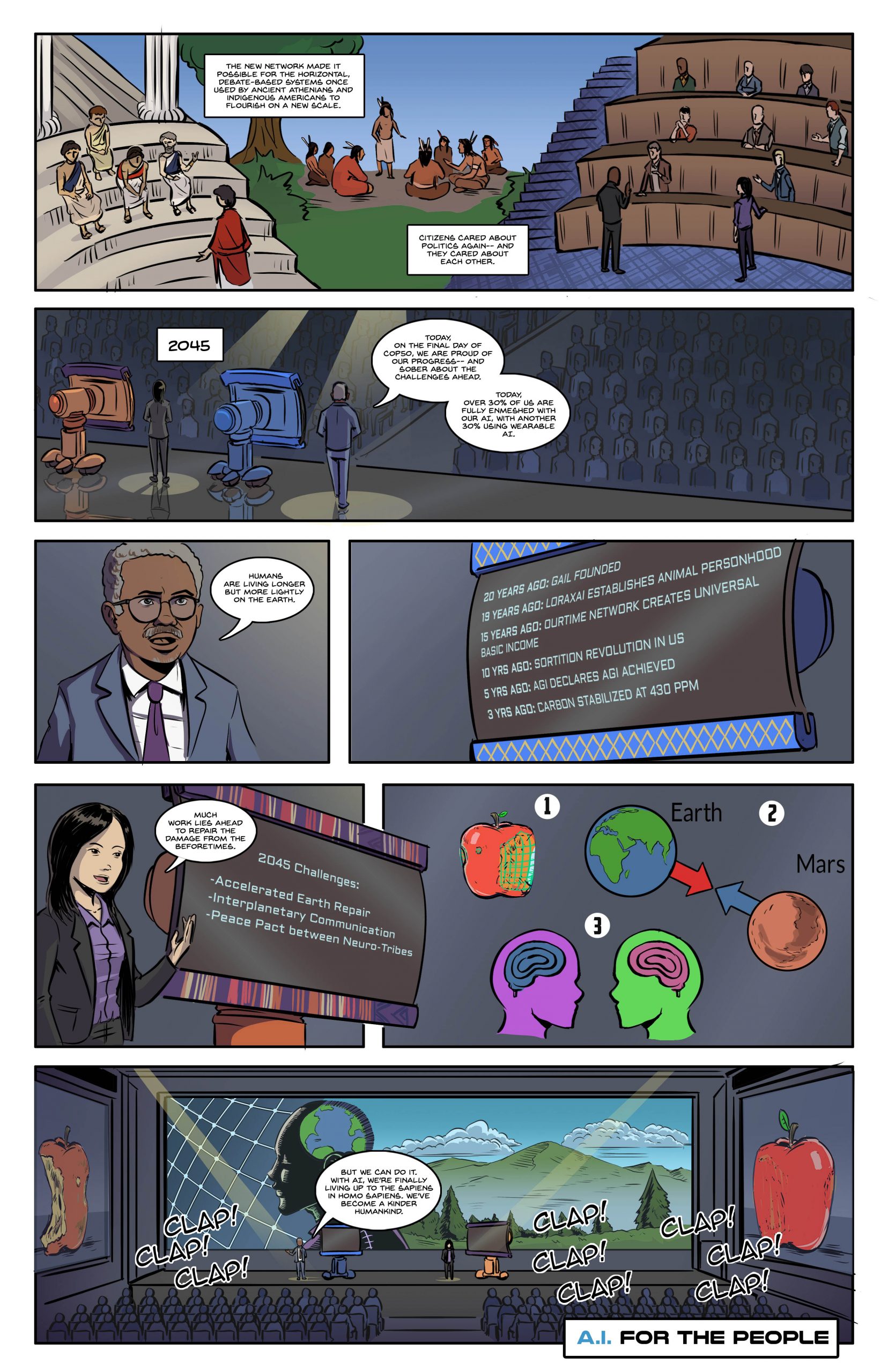
The Team

Chi Rainer Bornfree
Chiara Ricciardone earned their PhD in Rhetoric from UC Berkeley and have taught at Bard, Princeton, and NY State Correctional facilities. Now they write fiction, essays, letters, and more in the Hudson Valley. Read more about Chiara at www.chiararicciardone.com
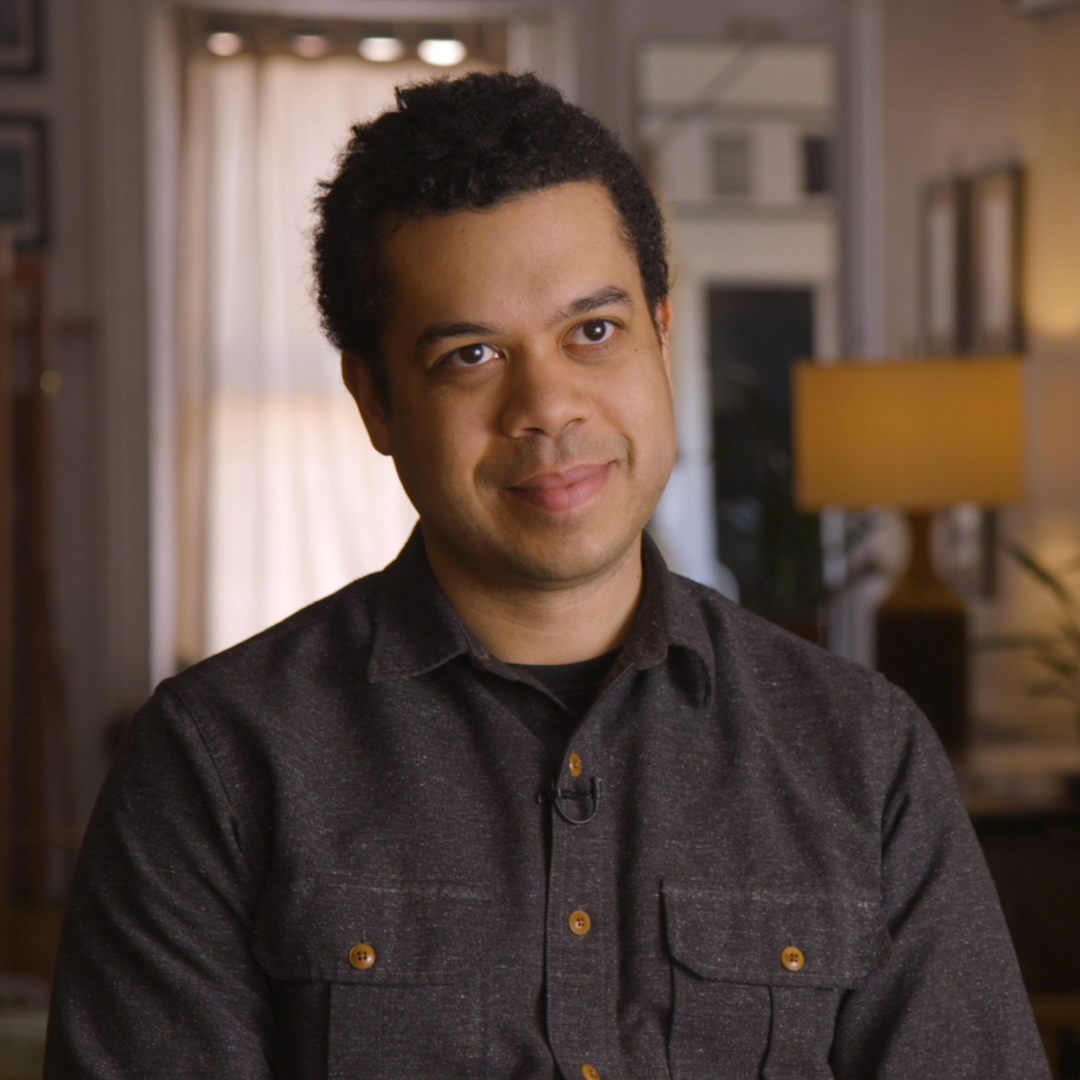
Micah White
Known for co-creating Occupy Wall Street, Micah is the author of “The End of Protest.” His primary focus is now on the social potential of cryptocurrencies. Learn more about Micah at micahmwhite.com

J.R. Harris
J.R. Harris is a freelance illustrator/comic artist from Flint, Michigan. Since 2016, he has worked with various companies to create a number of graphic novels, illustrated products, and tv commercials. Find his work at jrcomicart.com

